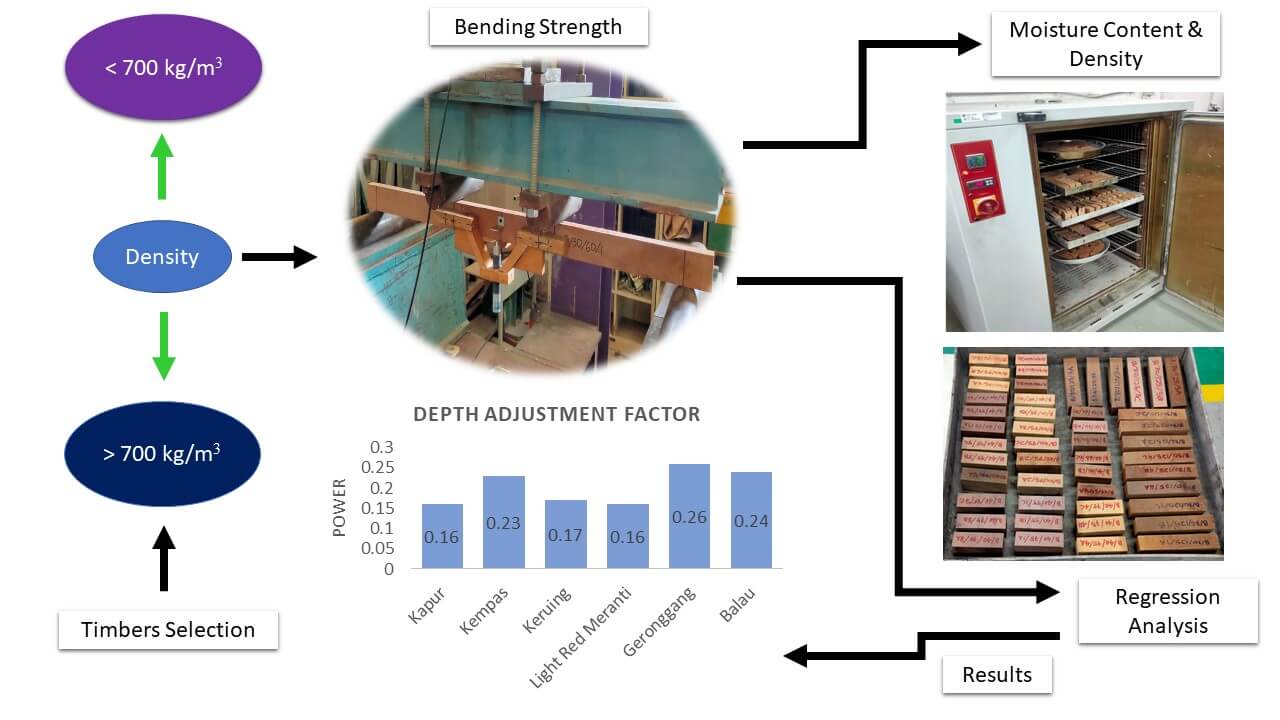 Open Access
Open Access
ARTICLE
Verification of Depth Adjustment Factor in Eurocode 5 for Tropical Hardwood Timbers
1
School of Civil Engineering, College of Engineering, Universiti Teknologi MARA Malaysia, Shah Alam, Selangor, 40450, Malaysia
2
Institute for Infrastructure Engineering and Sustainable Management (IIESM), Universiti Teknologi MARA Malaysia, Shah Alam,
Selangor, 40450, Malaysia
3
Malaysian Timber Industry Board (MTIB), Cheras, Kuala Lumpur, 56100, Malaysia
* Corresponding Author: Zakiah Ahmad. Email:
(This article belongs to the Special Issue: Advances in Eco-friendly Wood-Based Composites: Design, Manufacturing, Properties and Applications)
Journal of Renewable Materials 2023, 11(9), 3533-3546. https://doi.org/10.32604/jrm.2023.028675
Received 03 January 2023; Accepted 24 March 2023; Issue published 20 July 2023
Abstract
The depth adjustment factor for bending strength stated in Eurocode 5 (EC5) is only applicable to timbers having a characteristic density below 700 kg/m3 . However, most Malaysian timbers are hardwood, some with a characteristic density reaching above 700 kg/m3 . Therefore, the objective of this study was to examine whether the depth adjustment factor stipulated in EC5 is valid for Malaysian hardwood timbers. Six timber species were selected for this study, namely Kapur (Dryobalanops C.F.Gaertn.), Kempas (Koompassia Maingay ex Benth.), Keruing (Dipterocarpus C.F.Gaertn.), Light red meranti (Shorea Roxb. ex C.F.Gaertn.), Geronggang (Cratoxylum Blume) and Balau (Shorea Roxb. ex C.F.Gaertn.). The determination of bending strength and characteristic density was conducted according to BS EN 408: 2010 and BS EN 384: 2016, respectively. A graph for mean bending strength vs. (150/h) was plotted for each timber species. The power function was selected to analyze the relationship between the two variables. The power of the regression equations varied depending on the characteristic density of the timber species. For species with a characteristic density below 700 kg/m3 , such as Kapur, Keruing, and Light red meranti, the power was between 0.16 to 0.17. In contrast, for species having a characteristic density above 700 kg/m3 , namely Kempas and Balau, the power was higher at 0.23 and 0.24, respectively. Geronggang was an exception to this pattern. These values are close to the depth adjustment factor given in EC5, which is 0.2. Based on the results, it can be suggested that the adjustment factor of 0.2 is also applicable to Malaysian hardwood timbers with a characteristic density above 700 kg/m3Graphic Abstract

Keywords
Cite This Article
 Copyright © 2023 The Author(s). Published by Tech Science Press.
Copyright © 2023 The Author(s). Published by Tech Science Press.This work is licensed under a Creative Commons Attribution 4.0 International License , which permits unrestricted use, distribution, and reproduction in any medium, provided the original work is properly cited.


 Submit a Paper
Submit a Paper Propose a Special lssue
Propose a Special lssue View Full Text
View Full Text Download PDF
Download PDF Downloads
Downloads
 Citation Tools
Citation Tools